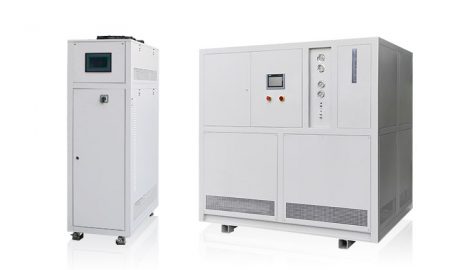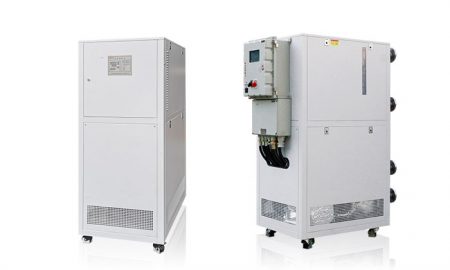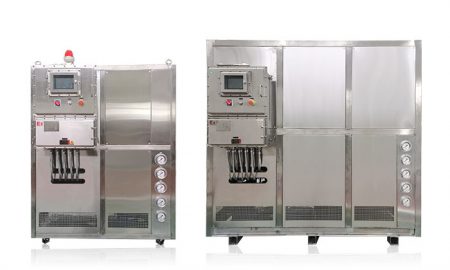Temperature Control Unit for Fluid Heater and Chiller
Kontaktieren Sie uns noch heute für die perfekte Lösung zur Temperaturkontrolle
The temperature control unit is a type of temperature control equipment commonly used in industrial production. Its main function is to transport heating or refrigeration media to equipment that needs to be heated or cooled to meet the temperature control requirements during the production process.
1. Principle of temperature control unit for fluid heater and chiller
The working principle of the TCU temperature control system is to transport the heating or cooling medium through pipelines to the equipment that needs to be heated or cooled, and monitor the temperature inside the equipment in real time through sensors, and perform heating or cooling according to the set temperature control mode. Specifically, the temperature control unit mainly consists of heater, cooler, circulation pump, controller and other parts. When heating is required, the heater will heat the heating medium to the set temperature, and the circulation pump will transport the heated medium to the equipment that needs to be heated. When cooling is required, the cooler will cool the medium to the set temperature, and the circulation pump will transport the cooled medium to the equipment that needs to be cooled. The controller is responsible for monitoring and adjusting the temperature inside the equipment to ensure that the temperature of the equipment is always within the set range.

2. Structure of temperature control unit for fluid heater and chiller
The structure of the TCU temperature control system is mainly composed of heaters, coolers, circulation pumps, pipelines, sensors, controllers and other parts. Among them, heaters and coolers are used to heat and cool the medium, the circulation pump is responsible for transporting the heated or cooled medium to the equipment that needs to be heated or cooled, the pipeline is used to connect various parts, and the sensor is used to monitor the temperature inside the equipment and control The controller is used to control heaters, coolers, circulation pumps, etc. to achieve high-precision control of equipment temperature.
3. Characteristics of temperature control unit for fluid heater and chiller
High precision: The TCU temperature control system adopts high-precision control technology, which can achieve high-precision control of temperature, and the accuracy can reach ±0.1℃.
Good stability: The circulation system of the TCU temperature control system adopts a closed cycle method, which can avoid temperature fluctuations and make the temperature control more stable.
E-Mail: info@lneya.com WeChat ID: +8615251628237 WhatsApp: +86 17851209193

Kühl- und Heizsysteme (Serie SUNDI)
Temperaturregelbereich: -120°C bis +350°C
Anwendung: Verschiedene Reaktoren (Mikrokanäle, Glas, ummantelte Reaktoren usw.), Destillations- oder Extraktionssysteme, Labor, Universität, Forschungsinstitut, Luft- und Raumfahrt, Automobilindustrie, Halbleiter- und Elektrotests, Chemie, Pharmazie, Petrochemie, Biochemie, Medizin, Krankenhaus, F&E-Werkstatt, Luft- und Raumfahrt, Biologie und andere Industrien.
| Temperaturbereich | Serie -10 ~ +150°C | Serie -25 ~ +200°C | Serie -25 ~ +300°C | Serie -45 ~ +250°C | Serie -45 ~ +300°C | Serie -60 ~ +250°C | Serie -60 ~ +300°C | Serie -70 ~ +250°C | Serie -80 ~ +250°C | Serie -90 ~ +250°C | Serie -100 ~ +100°C | -25 ~ +200°C eine Maschine für zwei Reaktoren | -40 ~ +200°C eine Maschine für zwei Reaktoren |
| Kühlleistung | 1,5 ~ 15kW | 1 ~ 200kW | 1 ~ 200kW | 0,45 ~ 200kW | 0,9 ~ 25kW | 0,25 ~ 60kW | 0,75 ~ 25kW | 0,4 ~ 15kW | 0,3 ~ 80kW | 0,2 ~ 80kW | 0,45 ~ 80kW | bis zu 10*2kW | bis zu 10*2kW |
| Hinweis: Jeder Temperaturbereich von -150℃ ~ +350℃ und jede Kühlleistung kann angepasst werden | |||||||||||||

Kühl- und Heizsysteme (WTD-Serie)
(Mikrokanal / Röhrenreaktoren spezialisiert)
Temperaturregelbereich: -70°C bis +300°C
Spezielles Design für Mikrokanäle (geringe Flüssigkeitsspeicherkapazität, starke Wärmeaustauschkapazität, Zirkulationssystem mit hohem Druckabfall)
| Temperaturbereich | -70°C ~ +300°C | -45°C ~ +250°C | -70°C ~ +200°C | ||||||
| Kühlleistung | 1.1 ~ 7.5kW | 1.5 ~ 5.5kW | 11 ~ 50kW | ||||||
| Hinweis: Jeder Temperaturbereich von -150℃ ~ +350℃ und jede Kühlleistung kann angepasst werden | |||||||||

Umwälzpumpen für Kühlung und Heizung
Temperaturregelbereich: -45°C bis +250°C
Anwendung: Verschiedene Reaktoren (Mikrokanäle, Glas, ummantelte Reaktoren usw.), Destillations- oder Extraktionssysteme, Labor, Universität, Forschungsinstitut, Luft- und Raumfahrt, Chemie, Pharmazie, Petrochemie, Biochemie, Medizin, Krankenhaus, F&E-Werkstatt, Luft- und Raumfahrt, Biologie und andere Industrien.
| Temperaturbereich | Serie -25°C ~ +200°C | Serie -45°C ~ +250°C | |||||||
| Kühlleistung | 1 ~ 15kW | 0,25 ~ 15kW | |||||||
| Hinweis: Jeder Temperaturbereich von -150℃ ~ +350℃ und jede Kühlleistung kann angepasst werden | |||||||||

Heizungsumwälzpumpen
Temperaturregelbereich: +50°C bis +300°C
Hinweis: Die UC-Serie kann die Temperatur des Wärmeträgermediums regeln. Die UST-Serie kann nicht nur die Temperatur des Wärmeträgermediums, sondern auch die Temperatur des Reaktionsmaterials regeln.
| Temperaturbereich | +50°C ~ +170°C (UC-Serie) | +50°C ~ +300°C (UC-Serie) | +50°C ~ +300°C (UST-Serie) | ||||||
| Heizleistung | 5,5 ~ 15kW | 3,5 ~ 130kW | 3,5 ~ 95kW | ||||||
| Hinweis: Jeder Temperaturbereich von -150℃ ~ +350℃ und jede Kühlleistung kann angepasst werden | |||||||||

TCU Multireaktoren Temperaturkontrollsystem
Temperaturregelbereich: -120°C bis +250°C
Anwendung: Verschiedene Reaktoren (Mikrokanäle, Glas, ummantelte Reaktoren usw.), Destillations- oder Extraktionssysteme, Labor, Universität, Forschungsinstitut, Luft- und Raumfahrt, Chemie, Pharmazie, Petrochemie, Biochemie, Medizin, Krankenhaus, F&E-Werkstatt, Luft- und Raumfahrt, Biologie und andere Industrien.
| Temperaturbereich | Serie -45°C ~ +250°C | -120°C ~ +250°C Reihe | Kundenspezifisches Temperaturkontrollsystem | RT+10°C ~ +135°C | |||||
| Heizleistung | 25 ~ 80kW | 25 ~ 80kW | Benutzerdefiniert | 25 ~ 300kW | |||||
| Hinweis: Jeder Temperaturbereich von -150℃ ~ +350℃ und jede Kühlleistung kann angepasst werden | |||||||||
 LNEYA
LNEYA
 简体中文
简体中文


















































































